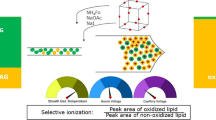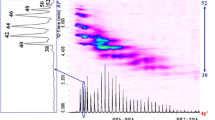Abstract
This study was undertaken to determine whether triple-stage mass spectrometry (MS3) could be employed to obtain quantitative and regioisomeric data from complex oil samples without the need for a chromatographic step in the analysis protocol. Lithium-7 trifluoroacetate and electrospray ionization were used to form lithium adducts of the triacylglycerols (TAG) in a fish oil sample. The first-generation precursor ion was the lithium-TAG adduct, the second-generation precursor ion was formed by loss of a neutral acid side chain in the first fragmentation. The ions used for analysis were formed in the second fragmentation by loss of the lactones of the acid side chains remaining after the first fragmentation. This analysis scheme provided quantitative and regioisomeric data without interference from TAG in the sample other than TAG with the same acyl carbon number, one more double bond, and two acyl side chains in common with the analyte. Even in this case a majority of the interferences could be estimated and compensated. Analysis of synthetic samples containing the fish oil matrix indicated that both absolute and relative quantitative data could be obtained with average errors of approximately 5 %. The method proved well suited to routine analyses of complex oil samples.


Similar content being viewed by others
References
Leskinen H, Suomela J-P, Kallio H (2007) Quantification of triacylglycerol regioisomers in oils and fat using different mass spectrometric and liquid chromatographic methods. Rapid Commun Mass Spectrom 21:2361–2373
Holčapek M, Dvořáková H, Lísa M, Girón AJ, Sandra P, Cvačka J (2010) Regioisomeric analysis of triacylglycerols using silver-ion liquid chromatography-atmospheric pressure chemical ionization mass spectrometry: comparison of five different mass analyzers. J Chromatogr A 1217:8186–8194
Hellmuth C, Uhl O, Segura-Moreno M, Demmelmair H, Koletzko B (2011) Determination of acylglycerols from biological samples with chromatography-based methods. J Sep Sci 34:3470–3483
Kalo PJ, Kemppinen A (2012) Regiospecific analysis of TAG using chromatography, MS, and chromatography-MS. Eur J Lipid Sci Technol 114:399–411
Samburova V, Lemos MS, Hiibel S, Hoekman SK, Cushman JC, Zielinska B (2013) Analysis of triacylglycerols and free fatty acids in algae using ultra-performance liquid chromatography mass spectrometry. J Am Oil Chem Soc 90:53–64
Fridriksson EK, Shipkova PA, Sheets ED, Holowka D, Baird B, McLafferty FW (1999) Quantitative analysis of phospholipids in functionally important membrane domains from RBL-2H3 mast cells using tandem high-resolution mass spectrometry. Biochem 38:8056–8063
Ekroos K, Chernushevich IV, Simons K, Shevchenko A (2002) Quantitative profiling of phospholipids by multiple precursor ion scanning on a hybrid quadrupole time-of-flight mass spectrometer. Anal Chem 74:941–949
Han X, Gross RW (2003) Global analyses of cellular lipidomes directly from crude extracts of biological samples by ESI mass spectrometry: a bridge to lipidomics. J Lipid Res 44:1071–1079
Ishida M, Yamazaki T, Houjou T, Imagawa M, Harada A, Inoue K, Taguchi R (2004) High-resolution analysis by nano-electrospray ionization Fourier transform ion cyclotron resonance mass spectrometry for the identification of molecular species of phospholipids and their oxidized metabolites. Rapid Commun Mass Spectrom 18:2486–2494
Liebisch G, Lieser B, Rathenberg J, Drobnik W, Schmitz G (2004) High-throughput quantification of phosphatidylcholine and sphingomyelin by electrospray ionization tandem mass spectrometry coupled with isotope correction algorithm. Biochim Biophys Acta 1686:108–117
Han X, Gross WR (2005) Shotgun lipidomics: electrospray ionization mass spectrometric analysis and quantitation of cellular lipidomes directly from crude extracts of biological samples. Mass Spectrom Rev 24:367–412
Currie GJ, Kallio H (1993) Triacylglycerols of human milk: rapid analysis by ammonia negative ion tandem mass spectrometry. Lipids 28:217–222
Cheng C, Gross ML, Pittenauer E (1998) Complete structural elucidation of triacylglycerols by tandem sector mass spectrometry. Anal Chem 70:4417–4426
Hsu F-F, Turk J (1999) Structural characterization of triacylglycerols as lithiated adducts by electrospray ionization mass spectrometry using low-energy collisionally activated dissociation on a triple stage quadrupole instrument. J Am Soc Mass Spectrom 10:587–599
Han X, Gross RW (2001) Quantitative analysis and molecular species fingerprinting of triacylglyceride molecular species directly from lipid extracts of biological samples by electrospray ionization tandem mass spectrometry. Anal Biochem 295:88–100
Kurvinen J-P, Sjövall O, Kallio H (2002) Molecular weight distribution and regioisomeric structure of triacylglycerols in some common human milk substitutes. J Am Oil Chem Soc 79:13–22
McAnoy AM, Wu CC, Murphy RC (2005) Direct qualitative analysis of triacylglycerols by electrospray mass spectrometry using a linear ion trap. J Am Soc Mass Spectrom 16:1498–1509
Kallio H, Tuomasjukka S, Johansson A, Tahvonen R, Nieminen N, Sjövall O, Kurvinen J-P, Kivini H (2005) Analysis of regioisomers of triacylglycerols of northern currant seed oil by tandem mass spectrometry. Eur J Lipid Res Technol 107:101–106
Pittenauer E, Allmaier G (2009) The renaissance of high-energy CID for structural elucidation of complex lipids: MALDI-TOF/RTOF-MS of alkali cationized triacylglycerols. J Am Soc Mass Spectrom 20:1037–1047
Hsu F-F, Turk J (2010) Electrospray ionization multiple-stage linear ion-trap mass spectrometry for structural elucidation of triacylglycerols: assignment of fatty acyl groups on the glycerol backbone and location of double bonds. J Am Soc Mass Spectrom 21:657–669
Attya M, Russo A, Perri E, Sindona G (2012) Endogenous lipase catalyzed transesterification of olive oil fats. The formation of isomeric and oligomeric triacylglycerols. J Mass Spectrom 47:1247–1253
Kubo A, Satoh T, Itoh Y, Hashimoto M, Tamura J, Cody RB (2013) Structural analysis of triacylglycerols by using a MALDI-TOF/TOF system with monoisotopic precursor selection. J Am Soc Mass Spectrom 24:684–689
Son J, Lee G, Cha S (2014) Direct analysis of triacylglycerols from crude lipid mixtures by gold nanoparticle-assisted laser desorption/ionization mass spectrometry. J Am Soc Mass Spectrom 25:891–894
Fauconnot L, Hau J, Aeschlimann J-M, Fay L-B, Dionisi F (2004) Quantitative analysis of triacylglycerol regioisomers in fats and oils using reversed-phase high-performance liquid chromatography and atmospheric pressure chemical ionization mass spectrometry. Rapid Commun Mass Spectrom 18:218–224
Manicke NE, Wiseman JM, Ifa DR, Cooks RG (2008) Desorption electrospray ionization (DESI) mass spectrometry and tandem mass spectrometry (MS/MS) of phospholipids and sphingolipids: ionization, adduct formation, and fragmentation. J Am Soc Mass Spectrom 19:531–543
Mandal MK, Yoshimura K, Chen LC, Yu Z, Nakazawa T, Katoh R, Fujii H, Takeda S, Nonami H, Hiraoka K (2012) Application of probe electrospray ionization mass spectrometry (PESI-MS) to clinical diagnosis: solvent effect on lipid analysis. J Am Soc Mass Spectrom 23:2043–2047
Grossert JS, Cubero Herrera L, Ramaley L, Melanson JE (2014) Studying the chemistry of cationized triacylglycerols using electrospray ionization mass spectrometry and density functional theory computations. J Am Soc Mass Spectrom 25:1421–1440
Byrdwell WC, Neff WE (2002) Dual parallel electrospray ionization and atmospheric pressure chemical ionization mass spectrometry (MS), MS/MS and MS/MS/MS for the analysis of triacylglycerols and triacylglycerol oxidation products. Rapid Commun Mass Spectrom 16:300–319
Lin J-T, Arcinas A (2008) Analysis of regiospecific triacylglycerols by electrospray ionization-mass spectrometry of lithiated adducts. J Agric Food Chem 56:4909–4915
Cubero Herrera L, Ramaley L, Potvin MA, Melanson JE (2013) A method for determining regioisomer abundances of polyunsaturated triacylglycerols in omega-3 enriched fish oils using reversed-phase liquid chromatography and triple-stage mass spectrometry. Food Chem 139:655–662
Ramaley L, Cubero Herrera L, Melanson JE (2013) Applicability of non-linear versus linear fractional abundance calibration plots for the quantitative determination of triacylglycerol regioisomers by tandem mass spectrometry. Rapid Commun Mass Spectrom 27:1251–1259
Tang L, Kebarle P (1993) Dependence of ion intensity in electrospray mass spectrometry on the concentration of the analytes in the electrosprayed solution. Anal Chem 65:3654–3668
Cech NB, Enke CG (2001) Practical implications of some recent studies in electrospray ionization fundamentals. Mass Spectrom Rev 20:362–387
Nilsson LB, Skansen P (2012) Investigation of absolute and relative response for three different liquid chromatography/tandem mass spectrometry systems; the impact of ionization and detection saturation. Rapid Commun Mass Spectrom 26:1399–1406
Chen J, Green KB, Nichols KK (2013) Quantitative profiling of major neutral lipid classes in human meibum by direct infusion electrospray ionization mass spectrometry. Invest Ophthalmol Vis Sci 54:5730–5753
Kurvinen J-P, Rua P, Sjövall O, Kallio H (2001) Software (MSPECTRA) for automatic interpretation of triacylglycerol molecular mass distribution spectra and collision induced dissociation product ion spectra obtained by ammonia negative ion chemical ionization mass spectrometry. Rapid Commun Mass Spectrom 15:1084–1091
Ramaley L, Cubero Herrera L (2008) Software for the calculation of isotope patterns in tandem mass spectrometry. Rapid Commun Mass Spectrom 22:2707–2714
Malone M, Evans JJ (2004) Determining the relative amounts of positional isomers in complex mixtures of triglycerides using reversed-phase high-performance liquid chromatography-tandem mass spectrometry. Lipids 39:273–284
Acknowledgments
The authors wish to acknowledge the helpful discussions with Prof. J. S. Grossert during the preparation of this manuscript.
Author information
Authors and Affiliations
Corresponding author
Electronic supplementary material
Below is the link to the electronic supplementary material.
About this article
Cite this article
Ramaley, L., Herrera, L.C. & Melanson, J.E. Quantitative Analysis of TAG in Oils Using Lithium Cationization and Direct-Infusion ESI Tandem Mass Spectrometry. J Am Oil Chem Soc 92, 323–334 (2015). https://doi.org/10.1007/s11746-015-2604-9
Received:
Revised:
Accepted:
Published:
Issue Date:
DOI: https://doi.org/10.1007/s11746-015-2604-9




